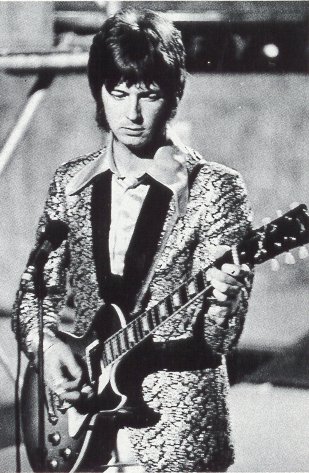
Cats Squirrel
This is one of the most exciting Fresh Cream studio cuts.
This old blues cover is based on an open E chord. The only variation is the first change from the opening E chord is just an A note making it (technically speaking) an open E11 or E eleventh chord. Clapton than alternates sporadically between E11 and an A triad at the second fret (where he bars the inner three strings, B, G and D strings) with his third (most likely) finger also touching the E string on the second fret, causing his pick to occasionally hit that note which produces the sixth overtone (F sharp).
The rhythm guitar track is the Les Paul, with moderate volume level and on the treble toggle position with treble tone turned slightly down to roll off the edge. Unless he was on mid-toggle position with bass pick-up down and treble pick-up higher but when I see close up pictures of Clapton's guitars, they are usually on Treble toggle position which is consistent with his most common tone [not woman tone] and also used for his rhythm.
After the guitar chord intro, Clapton comes in with his second (the overdub) guitar, on treble toggle position and at a much higher volume level, and cranks out that wonderful theme - riffin’ the high register E position, 12th fret, which is in unison with Bruce’s harmonica. During that main riff, Clapton uses mostly full note bending, predominately, on the second and third strings with a wonderful stretch vibrato on the 15th note into the riff (the second bend to the E note on the 15th fret second string, from D). His smooth flowing string bending, picking and fingerwork blend masterfully with the harp, slightly smoother than on "Rollin’ and Tumblin’ ", which is meant to be a little harder edged.
After the main riff sequence, Clapton slips back down to the open E position and follows the remaining theme still in unison with the harmonica but using harder picked notes on the 3rd and fourth strings, first and second fret. This continues at a hectic pace until they stop and Bruce begins his "alright alright alright alright, alright alright alright"....etc... This sequence is one of Creams most exciting studio climaxes. The tension that is built during Bruces vocal perfectly anticipates Claptons soaring guitar break. As soon as Bruce stops, Clapton cuts loose all alone, with a high register riff on the 12th position. He hits the first climax with a perfectly executed stretch vibrato (reaching the E note on second string) with Baker crashing in on that precise beat. That vibrato is significant to an experienced guitarist due to it's phenomenal control and perfect sonic ambience. Usually a guitarist will be heard bending up a little before the target note is hit. In this case Clapton hits the note and the vibrato with unrivaled precision which as a result resonated even more of a chill and prepares the listener for more dynamics. After that vibrato, Clapton artistically waves that same bent note before descending on the next beat and joined by Baker and Erics rhythm guitar (open E chord). Than Bruces Harmonica and bass come in much later to join the drums and rhythm guitar bringing Erics solo to an exciting close. After the next three notes Clapton then flashes an appetizer of speed during a four note sequence before he settles into the next beat. With Baker and Bruce continually building tension on the designated beat, Clapton weaves and groans with agonizing third string bends then finally tapers off (all in minor modal positions) and beautifully descends back into the theme sequence on the first and second fret building density and volume with his pick.
This solo is a perfect example of Claptons ability to create architecture,displaying tension, climax and seamless descention back to the verse. He and Bruce re-create the main sequence riff again creating the illusion of an almost faster pace (maybe it is) before tapering off and fading for the end. Clapton does a quick bend 'ROLL' of the third string at the beginning of the previously described solo which is a way of quickly playing two notes with a fast bend and finger effect, rather than a straight half step up on one fret to reach the same note. This 'rolling' sound, was characteristic of his Bluesbreaker period, especially prominent in the tune 'Hideaway' and continues into Fresh Cream as shown here.
This rolling sound which is always done on the third string, stopped after Fresh Cream and was never heard again in any solo that’s been officially recorded. There is one bootleg version of Cat's Squirrel I have heard from an early 1967 concert. Clapton who is definitely using a Les Paul on the show, does another very exciting solo for Cat's Squirrel carrying over the same exhilarating feeling he generates on the studio version.

© Jeffrey Aarons, 1999